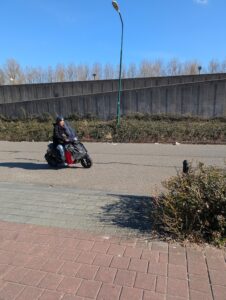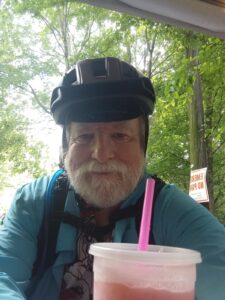 There’s a familiar metallic roar disturbing the peace of the Netherland’s bike paths.
There’s a familiar metallic roar disturbing the peace of the Netherland’s bike paths.
It’s the sound of gas-powered motorcycles. They’re supposed to be on the roads, but laws aren’t strictly enforced. They’re fast, and dangerous to the 15 mph (25 kph) traffic the paths were meant for. But they’re there, and their numbers are growing.
 You can electrify any form of transport, from standing scooters and motorized wheelchairs to bikes, cars, and trains. But there is always a trade-off between range and weight. You can bridge it in cars, skateboard designs with enormous batteries slung just over the roadway. On a bike you can easily ride to the limit of comfort on a single charge, as I found going from Utrecht to Amsterdam, where I met with an editor who had driven in to work, from Utrecht.
You can electrify any form of transport, from standing scooters and motorized wheelchairs to bikes, cars, and trains. But there is always a trade-off between range and weight. You can bridge it in cars, skateboard designs with enormous batteries slung just over the roadway. On a bike you can easily ride to the limit of comfort on a single charge, as I found going from Utrecht to Amsterdam, where I met with an editor who had driven in to work, from Utrecht.
It’s when we get to motorcycles that things get tough. A gas-powered motorcycle goes over 200 miles (300 km) on a tank of gas, refueling in minutes. Electrics have just half that range and can take an hour to charge, on the equivalent of a Tesla charger.
The electrics get better acceleration, but you’re not going to go Easy Rider on them. The range anxiety is real. Electrics will become competitive, as new battery designs and materials reach the market in a few years. Right now, they’re not.
This is separate from the issue of electric mopeds speeding along the bike paths, as sites like Bicycle Dutch have written about. Enforcing speed limits is one challenge, but the noise of gas-powered motorbikes can make a bike path no different than a highway. Worse, if you need the range, there’s nothing electric for you yet.
Fewer Trains

When you commit to a bike for your intra-city transit in the Netherlands, you commit to the trains for inter-city transit. I’m planning on doing that over the next month, starting with Rotterdam next week.
But COVID hit the Dutch NS train system hard. Demand may not return to 2019 levels until the end of the decade. The system has suffered through five years of losses. Reliability is declining, and it’s becoming less attractive to middle class commuters.
The response, in the short term, is to cut schedules and hike prices. This can lead to a death spiral, middle class people switching back to cars, making trains and buses the rides of the poor.
Cars don’t scale, but cars are convenient. They take you directly from your home, on your schedule, to wherever you want to go. My host here in Maarssen drives in from an hour away to visit, and as I noted the editor in Amsterdam is a car commuter. Trains that are late, trains that are dirty, trains that don’t arrive on time, all reduce demand, at a time when you badly want to increase it for the e-transport revolution.
The Nightmare

The cars get into the center of town and want to run at the same speed they do in the suburbs. When they can’t, and density says they can’t, drivers reject the city, calling it a crime-ridden hellhole.
It’s not, but it could become that again, if the e-transport revolution sputters.










